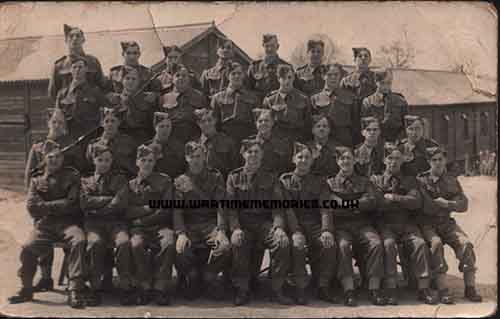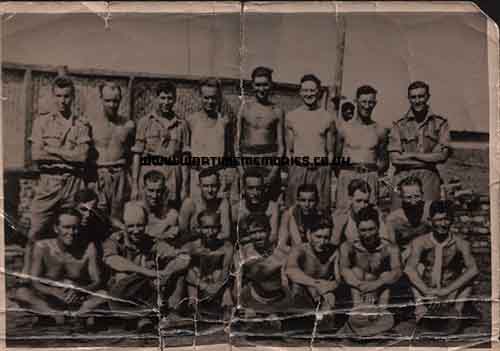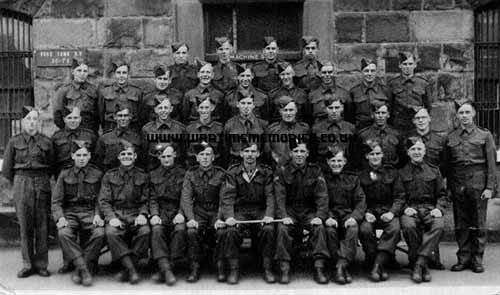Sgt. William Christopher James "Kit" Williams 35 L.A.A. Regt, 78 Bty. Royal Artliiery (d.1943)
My father William Williams was born on the 15th of December 1913 at 106, Upper Beau Street, South Everton, Lancashire. (Part of Liverpool) At birth he was registered as William Christopher Williams. James was added when he was Baptised, in accordance with Catholic tradition. This has led to some confusion over his middle names.
His father was William Nicholas Williams, a Bricklayer’s labourer, born at 42, Mere Lane, Everton, in 1886, he died before 1940. His father was born in Beaumaris, Anglesey, of a Welsh family, originally from Ruthin in North Wales. His mother was Agnes Williams (Nee Kane), Born at 138, Elias Street, Everton in 1888. She died c.1955. Her father was born in Everton of an Irish family which had come over from Ireland during the Irish Famine in 1851 or ‘52.
Brought up as a Catholic, my father was sent to a Catholic Boarding School, for his education, in which he did well. After leaving school, he entered the tailoring trade, specialising in invisible mending.
Although a Catholic, he was interested in all religions, and had visited a synagogue.
When the Second World War began he joined the Royal Artillery and trained as a Bofors (Anti-Aircraft) gunner, becoming a good shot.
(My daughter, Tamsin, has in her possession a part of a Target Drogue, which he shot down.)
His Regiment, the 35th was a special TA Regiment formed at Oxford on 2nd September 1939 for the defence of RAF airfields in the area against air attack. It recruited initially older men aged 25 to 50 (he was 26) and by early 1940 comprised five batteries with Headquarters at Oxford, Abingdon, Gloucester, Cheltenham and Reading. In mid 1940 this Regiment reverted to a normal Light Anti-Aircraft Regiment and was reduced to three batteries 78, 89 and 144.
My father was in 78 Battery. Battery HQ was in Reading. The RHQ was located in Black Hall, St Giles, Oxford.
He was posted to an ack-ack site in the village of Bramley, in North Hampshire, where he met my mother, who lived at the bottom of the hill on which the gun site had been built. These guns also protected the airfields at RAF Aldermaston and RAF Greenham and also the ammunition depot at Bramley.
On the 29th June 1940, aged 26, and now a Lance-Bombardier, he married Phoebe Helen Warner, aged 23, born 12th March 1917. Although he was still a Catholic and she was Church of England, they married in the C of E Church at Bramley. His Best Man was Edwin Randall, presumably one of his fellow Gunners.
He was then posted away, to a gun site at the I.C.I. factory at Mirfield, in Yorkshire. Here, they got the orders for mobilization. They were sent to a staging centre at Middlesborough, where the 78th made ready for the move to Scotland. It was here that the thought of going overseas proved too much for a couple of the lads. One shot himself in the foot and the other threw himself out of a bedroom window.
On the 14 July 1941, aged 27, now a full Bombardier (equivalent to Corporal), his son, Christopher Robin, was born. Presumably before his posting overseas, he was given a 48-hour pass to come down to see his new son, and we have some photos taken then. Obviously, I have no memory of him.
On the 8th November, 1941, 35 LAA was kitted out for Iraq and entrained for Gourock, on the Clyde.
At Gourock, on the 12th November 1941, his Regiment, the 35th Light Anti-Aircraft, boarded the converted liner the “Empress of Japan”, along with the 6th Heavy Anti-Aircraft Regiment, and others, and joined Convoy WS 12 ZM, bound for Basra, in the Persian Gulf, hence their sand coloured camouflage.
The convoy was escorted by the battleship “Royal Sovereign”, and Destroyers “Dulverton” and “Southwold”. The “Royal Sovereign” was one of the first ships to be fitted with Radar.
They left Gourock at 2345, on the 12th, superstition preventing any ship sailing on the 13th! The ship was carrying 50 crated Hurricane fighter aircraft, as well as the 53rd Infantry Brigade Group, 232 squadron RAF, the 85th Anti-Tank Regiment,and the 6th Heavy AA Regiment, along with 35 LAA.
On the 24th November, they put in at Freetown, but were not allowed ashore. Two days later, they left Freetown. As they were heading out to sea, a solid thump was heard on the side of the ship. It was a torpedo that had failed to explode.
The men enjoyed the luxury of the ex-liner, with its cinema and air-conditioning, as they rounded the Cape of Good Hope. On the 7th December 1941, the Japanese bombed Pearl Harbour - and the Americans entered the War.
After rounding the Cape, they docked at Durban on 19th December, for another four days, with shore leave. They were billeted ashore and wrote letters to their families, who were preparing for Christmas,
On the 21st, they were told that 35LAA and 6HAA were to be transferred to the SS “Narkunda”, an ex-P&O liner.
The “Narkunda” sailed on the 24th December (Christmas Eve!). This ship was not air-conditioned, having been built in 1920. They had only one Naval escort. After a few days at sea, the convoy was split into two. Due to the Japanese situation, the “Narkunda”, “Abbekerk” and some others were diverted to Singapore, as Convoy DM1, with escorts “Emerald”, “Exeter” and “Jumna”.
The troops, having been kitted out with clothing suitable for desert warfare in the Middle East, were hardly equipped for tropical climates and jungle conditions. Not only that, but much of their equipment, including their guns, were on another ship, possibly the “Abbekerk” .
On the 4th January, the convoy refuelled and watered in the Maldive Islands. Here they were joined by HMS “Durban”, and the Dutch Battlecruiser “De Ryter”. A day later the convoy was reinforced with another six naval escorts, including an Australian destroyer.
As they entered the South China Sea, three Dutch destroyers and a Norweigian ship joined the convoy..
The Japanese bombed Singapore on the 12th January 1942, and the convoy arrived in Keppel Harbour on the 13th. Major Cutbush, RA commandeered the Singapore Harbour Board Club as a billet for his men.
Next day, it was realised that they had no guns or equipment. Because of the explosive ordnance she carried, the “Abbekerk” was berthed in an isolated spot, and it may be she had all of the AA guns aboard, but it was felt too dangerous to unload her at the regular docks.
The men had nothing to fight with and the Japs were coming! Their torpedo bombers had already sunk the “Repulse” and the “Prince of Wales”.
Both formations were rearmed in Singapore from existing stocks. Upon rearming, 144 Battery and two troops of 89 Battery of 35 LAA Regiment were sent into Johore and went into action against enemy aircraft. 78 Battery remained in Singapore.
Whilst the British were hastening their defence preparations, General Tomoyuki Yamashita of the 14th Army Group of the Imperial Japanese Army was getting ready for the Japanese assault. The British Army in Malaya did not have any tanks whereas the Japanese had over two hundred. The Japanese Air Force were also able to carry out a series of air attacks on Allied positions. Under the command of General Yamashita, the Japanese made rapid progress as they forced Allied troops to retreat south. Unsuccessful attempts were made to halt the advance of General Yamashita at Perak River, Kampar and the Muar River.
On the 25th January 1942, General Arthur Percival gave orders for a general retreat across the Johore Strait to the island of Singapore.With the rest of the retreating army, 144 Battery fell back across the causeway into Singapore.
At this point, the story becomes confusing. On 30th January, 78 Battery commandeered a ship and left for Java. William was not aboard. I can only assume that my father, and possibly another man, Gunner Hatton, were somehow left behind, in Singapore.
On February 15, 1942, Singapore capitulated, with the personnel of 3 Battery, 6 HAA Regiment, and 35 LAA Regiment's HQ and 144 Battery becoming prisoners of war. My father was also captured, as we know from his Japanese POW Record Card, which gives the date of his capture as 15 February 1942. Strangely, his rank is given as “Gunner”, although he was in fact a Bombardier. Maybe the Japs didn’t know what that was, although he surely would have had his stripes on his uniform.
The prisoners were held in what had been the British Changi Camp. Soon after, a message was sent to my mother stating that William was a Prisoner at Changi.
The reverse of his Japanese POW Record Card informs us that on the 18th October, 1942, control of the Prisoners in Changi was transferred from Malay POW Camp to the Japanese 17th Army (New Guinea).
On that day, 600 men of the Royal Artillery, including my father, were marched to Singapore Docks and put aboard a ship. This ship was the Kenkon Maru, Sister ship of the Kenkon Maru
Of the 600 Gunners, 130 were from 35 LAA, mostly from 144 Battery. They were told that they were going to Japan. Herded into the hold of the ship, they endured horrific conditions. On the journey, it was noticed that the ship was definitely not heading for Japan, but was going south. The ship stopped at Surabaya Harbour, Java, on the 22nd Oct. then Timor, Bali and the Hialmarhere Islands. Many men were sick at this time and Battery Sgt Major Lambourne of the 11th Coast Regiment died from dysentery.
On the 5th November 1942, the ship docked at Rabaul, on the island of New Britain in the Solomon Islands Group, where the men were unloaded and marched along dusty tracks, ankle deep with volcanic ash, despite many being without footwear.
The Kenkon Maru, now without the prisoners, continued her voyage.
On the 21St of January, 1943, the U.S.Navy submarine SS 212 Gato torpedoed and damaged the Kenkon Maru. just East of Bougainville. (06°12'S, 155°51'E). Her escort then scuttles the ship. This was the action that led to the Japanese lie that the 600 Gunners had been "Lost at Sea". The British were informed of the action, and so my mother was told this on 5th March 1943.
This lie persists in both Japanese and British records. The prisoners had all disembarked at Rabaul.
The prisoners were marched from Rabaul to Kokopo Camp. From the start they were badly treated with consistent beatings and being tormented by the guards. During this period the men were made to work in the tropical sun. The Japanese interpreter, Higaki, was a Christian and did his best to help the prisoners, at some risk to himself.
On the 15th November 1942, a parade took place where the fittest 517 men, out of the remaining 599, were chosen to go to Ballali (Balalle) Island to build an airstrip. My father was amongst these men. They were taken by trucks to board another hell ship for the two day journey to Ballali. The island, which is approximately 4 miles in diameter, is one of the Shortland group of islands, just south of Bougainville.
Not one of these 517 men survived to tell their story. It was only through one of the few natives who lived on the island, and who had witnessed the events, that this story was able to be recorded by the Australian Forces who reoccupied the island some time later.
The first thing that happened was that a British Officer was shot. More atrocities followed. 81 men died from beatings, illness and from Allied bombing of the island. No-one knows whether my father was among these. The prisoners were not allowed to dig trenches for protection from the bombs.
In April 1943, the Japanese on Ballali Island were told by their headquarters that the US Navy was preparing for an attack. If this happened, all Prisoners were to be disposed of by whatever means was available.
On the 29th June 1943, an American warship bombarded the island. The next day the remaining 436 prisoners still alive were lined up and killed by sword or bayonet. The bodies were stripped of their identity tags and dumped in a large pit.
In November 1945, this mass grave, containing 436 bodies, was uncovered, confirming the facts. The remains of these British servicemen were recovered by 3 Division AIF, War Graves Unit of the Australian Army, and in December 1945 were finally interred in graves in the Port Moresby (Bomana) War Cemetery, in Papua, New Guinea.
As the bodies, when recovered, could not be identified, each one has an individual grave marked
"A Soldier of the 1939-1945 War Know Only to God". No-one knows whether my father was killed in the massacre, or had died before.
The official records still give the date of the death of all 600 Gunners as 5th March 1943, the date given for the sinking of the ship which they were no longer aboard, which is incorrect anyway.









